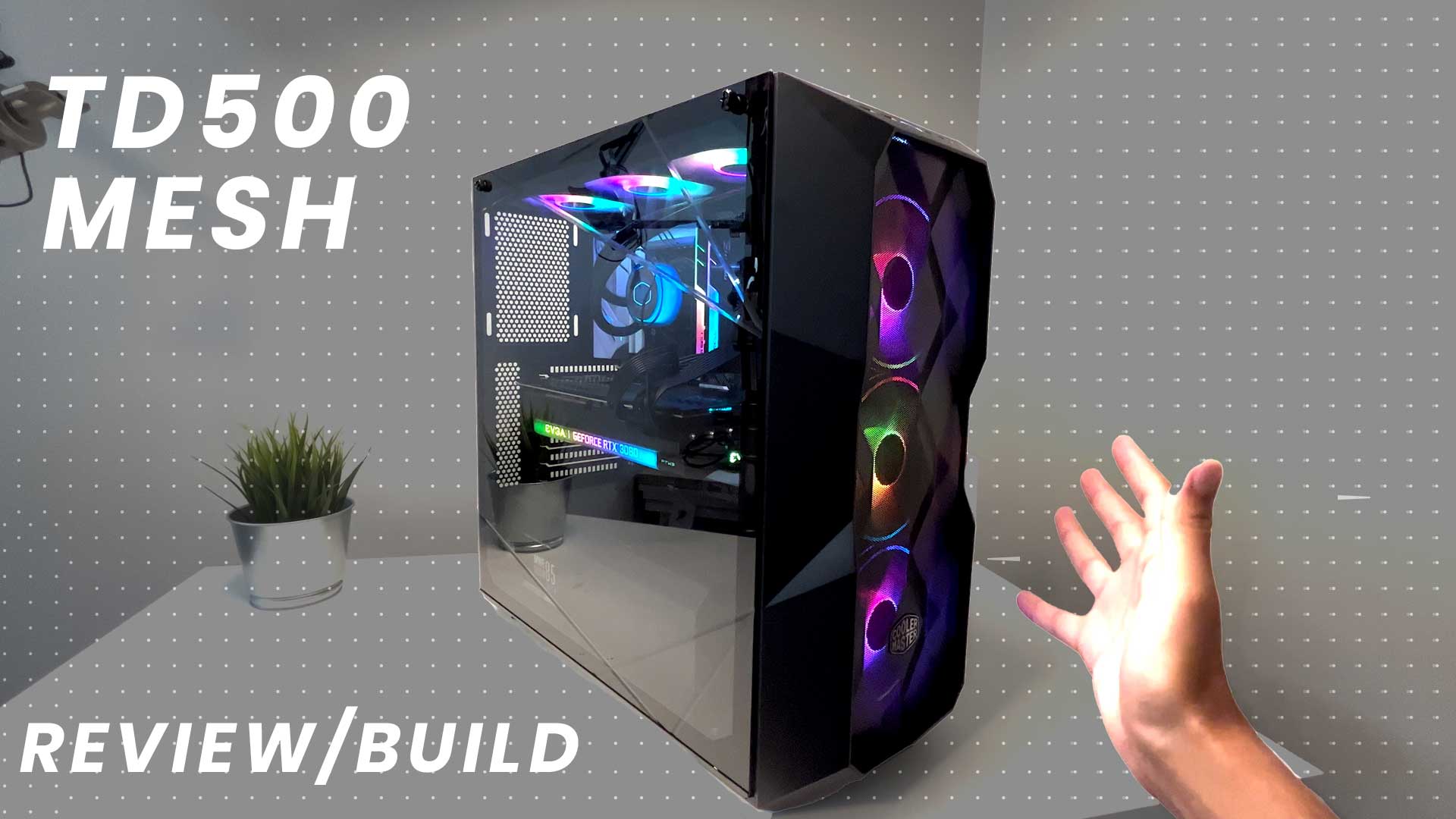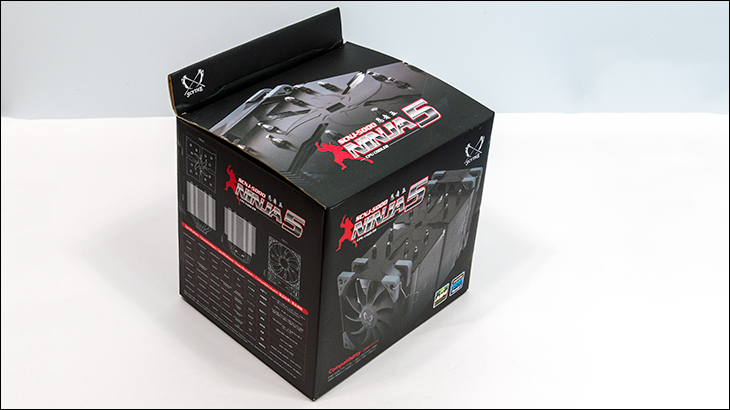
There really is no fair comparison with the Mugen 5 Rev.B as the Ninja 5’s shipping container is not only larger but also much more mature looking. Where the Mugen 5 Rev.B gave us flash backs to Japanese imports from the 90s the Ninja 5 is not a box we would hide for fear of ‘misunderstandings’. Put simply the Ninja 5’s is what a professional looking shipping container should look like. Of course, with that said there is still a ton of different languages on the back so Scythe has not entirely forgotten their roots.
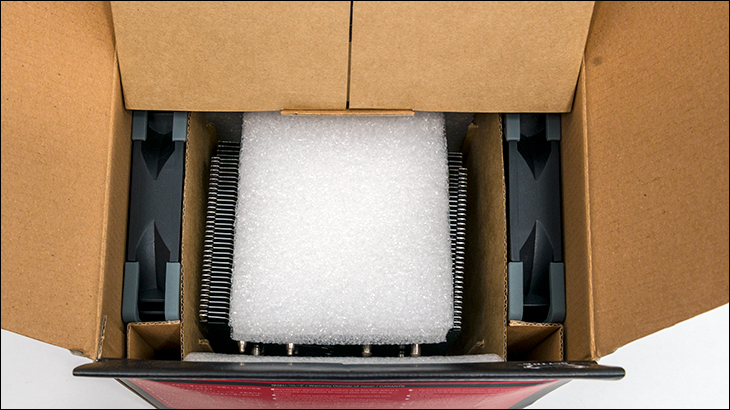
As for accessories, take the Mugen 5’s accessory list and up the ante with an additional fan (albeit the Ninja 5 does come with a slightly different variant of the fluid dynamic bearing based Kaze Flex 120mm series). To be precise when you open up the small cardboard box housed inside the top of the shipping container you can expect to find the following:
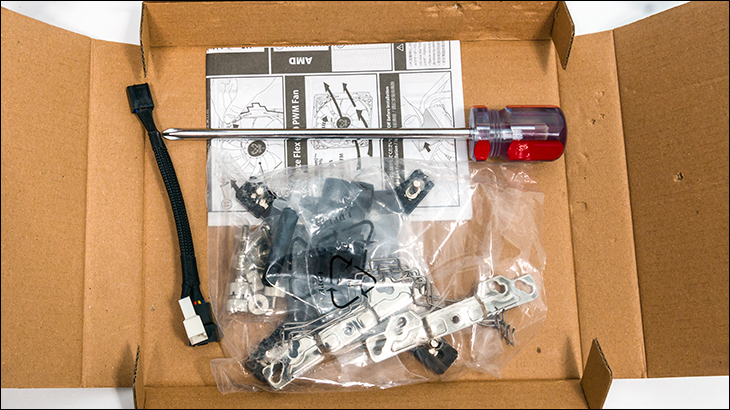
A good pictographic based installation pamphlet, a ton of mounting hardware (for everything from Intel 775 to 2066, AMD’s FM1 to FM2+, as well as AMD’s AM1 to AM4 socket type), a pair of fans, enough fan mounting brackets to mount said fans, a small tube of TIM, and a long screwdriver for making installation easier. That is rather an impressive list of accessories… and better still not one piece of goo-gaw (e.g. door knob hanger) or dross (e.g. case badge) to mar the overall great first impression this list makes.
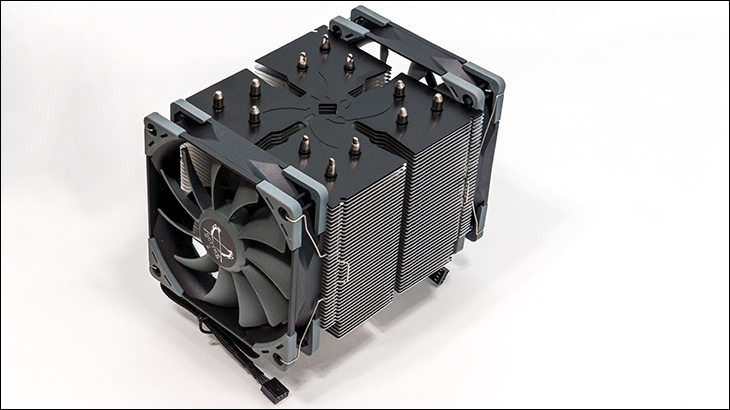
Much like with the shipping container, the best place to start in describing the Ninja 5 is how it differs from the Mugen 5 Rev.B. Much like the Mugen 5 Rev.B, Scythe has baked in all their latest refinements into their latest Ninja 5 series; however, in many ways the Ninja 5 is a much, much more advanced design. In fact, it is arguably one of the most advanced tower designs available. This is because the Ninja 5 may look like a mono-tower design with uber-thick cooling fins… but it in reality it is more accurate to call this a dual tower cooling design.
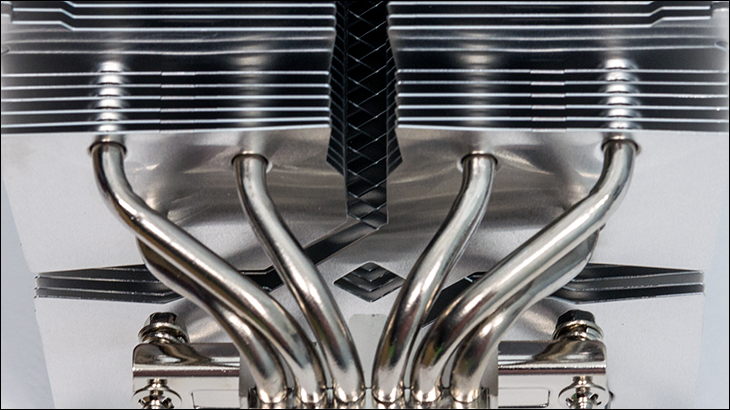
On first blush this may sound… well… starkers mad, but when to take a closer look at this tower you realize that not every fin is attached to every heat pipe. Instead each ‘level’ in the fin array actually is only connected to half the heat pipes – in an alternating fashion – just like in a classical ‘dual tower’ desing. Now unlike basically every other dual tower design Scythe has not taken a ‘left to right’ approach to the fin array (like in say a Noctua D15 cooler), instead each level is laid out in a crisscross fashion with one level being attached only the front left and rear right cluster of heat pipes, and the next being front right and rear left. To imagine this, think of double ended ‘arrows’ that overlapped with each arrow end having three holes in, through which heat pipes stick up through. Then take another double end arrow to cover the other ‘half’ of the heat pipes with only the middle of the arrows overlapping… and rinse and repeat and you have how the fin array(s) are laid out.
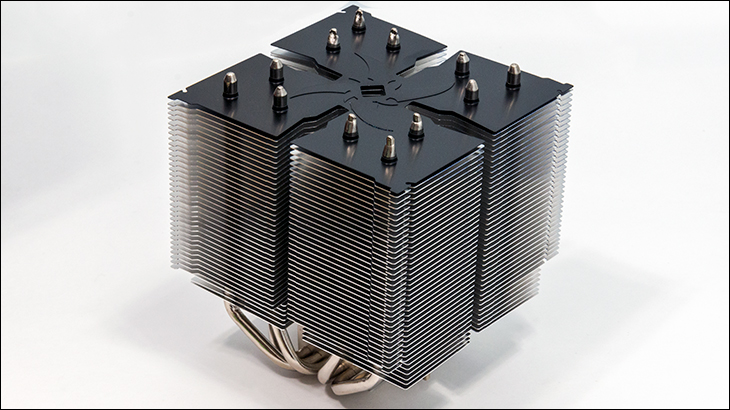
This design does have its pros and cons. On the negative side you can only attach two fans instead of three to the Ninja 5. On the positive, you get almost all the low static pressure abilities of typical ‘thin’ dual tower design (as the fins are spaced apart nicely and the ‘gap’ between each layer is large enough to not cause air to hang-up). Furthermore, the total surface area is much greater than a typical dual tower design… and yet the footprint is slightly smaller than typical dual tower designs. This configuration is also more sturdy and robust than typical dual towers as Scythe has attached the entire works at the top via a full coverage ‘topper’… which in reality is another ‘square’ or ‘full coverage’ cooling fin that just happens to be black and not silver in color – though we did wish they had made the bottom most fin a full coverage fin as well, as that would have further increased the stability of the fin array(s).
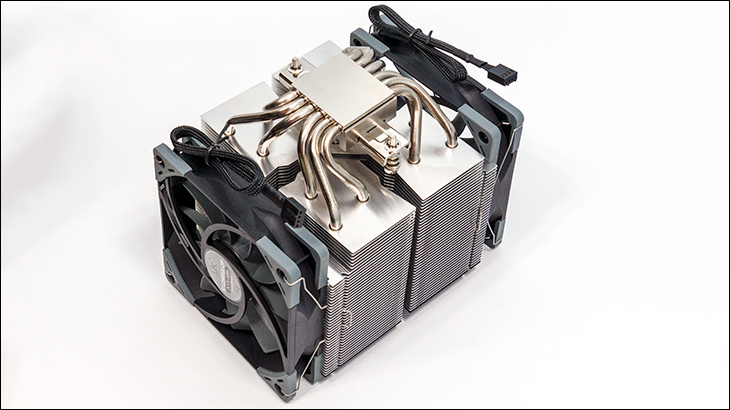
With this outside the box thinking the Ninja 5 can handle even greater heat loads than most cooling designs and yet they did not need to give it a foot-print as massive as typical dual towers. Of course, the downside is that people will perceive this massive tower as requiring high static pressure fans – unique fin stacking arrangement or not. The reality is actually much more nuanced. Yes, this massive cooler can indeed do an even better job at cooling with higher speed fans but this has more to do with increased air flow rate rather than the need for more ‘push’ to get the air through such a long distance.

This is because Scythe has made numerous design decisions beyond the stack, and spaced fins. The first is four large ‘cut outs’ in the fin arrays. Yes, this makes it look down right gorgeous, and with the added logo on the top… will remind people of a ‘ninja throwing star’ (aka Shuriken… but not to be confused with the Ninja Shuriken series) but the fact is these have been done to give the air being pushed from the ‘front’ of the fin array a place to escape before a mixture or old and new is sucked into the ‘back’ fin array. This works and works well. So well the coolness factor is simply a bonus.
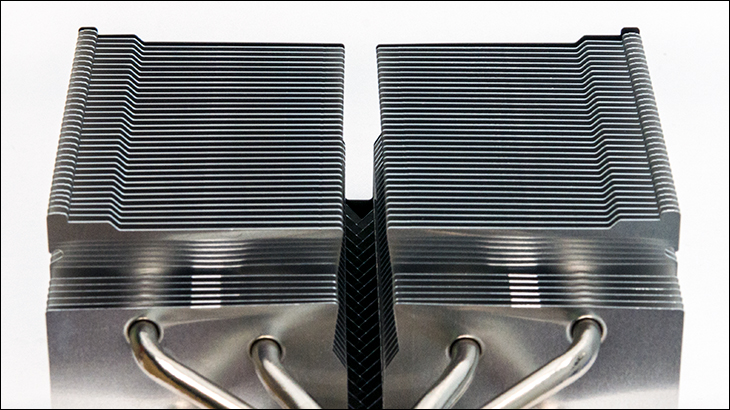
Next is each end of the fin array has an advanced ‘face’ that has numerous static pressure reducing features. Obviously two of the large ‘cutouts’ in the fins act as central fan hub dead zone remover, but by adding in a small standoff between the front of the of the face and the fan itself this gap further reduces static pressure requirements… as it basically is a fan shroud built into each ‘face’ of the Ninja 5. It does this by allowing the air to mix and mingle before entering the fin array. This mixing reduces air eddies caused by the rotating fans, removes dead zones and basically allows the air to flow cleanly through and over the fin array… before being able to escape out the middle of the Ninja 5.

Next is the layout of the six, 6mm ‘U’ shaped heat pipes. Each side of the Ninja 5 has them laid out in a V shape formation (with two V’s per face for a grand total of 4 clusters of heat pipes). This does a couple things. Firstly, it means the air does not slam into a wall of 6 heat pipes. Next as the air bends around the front heat pipes they are focused toward the rearmost, (and more) centrally located one. This allows all six of the heat pipes to get as much air movement as possible without greatly increasing static pressure. This combination in conjunction with the push-pull ‘out of the box’ fan configuration results in a tower design that really does not need high performance fans… and yet has most of the added benefits of thick ‘single tower’ design.
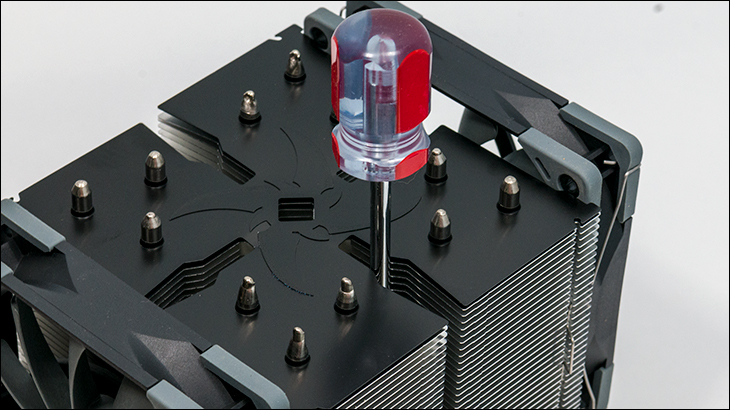
Now we must admit that a lot of this outside the box thinking (and we mean way, way outside the box) is a direct result of sheer necessity. Since this cooling solution does have a large foot-print Scythe’s engineers did have to include screwdriver holes in the fin array so you could mount the darn thing! This most likely is how it started… and with some thinking and playing the larger cutouts were the end result.
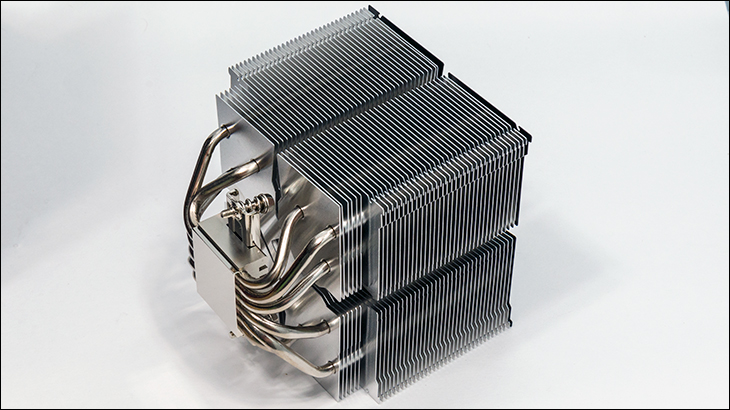
Now, as we will show you later in the installation section, this does come with a couple downsides. The first and most obvious is mounting such a large cooler can be tricky, and lining up the factory installed mounting bracket does take patience. You simply will not be able to clearly see them in the typical ‘looking down’ orientation. This is no big deal, but does make installing the Ninja 5 while the motherboard is inside a case less than easy to say the least.
The bigger issue is that the fin array is so large it will overhang the DIMMS. This is where the cutouts on both faces of the Ninja 5 come into play. Much like the Mugen 5 Rev.B, each face has a good chunk of the bottom fins removed so that the fin array can easily overhang your RAM and VRM heatsink. These cutouts work and work well and is the nifty point of their unique dual tower design… as it is a ton easier to work with than most mega-size coolers. It still is big, as it does have dimensions of 138 x 155 x 180 mm (with 2 fans attached), and tips the scales at 1190g (though that is also with two fans attached)… but it is not ‘I need a bigger motherboard’ big.
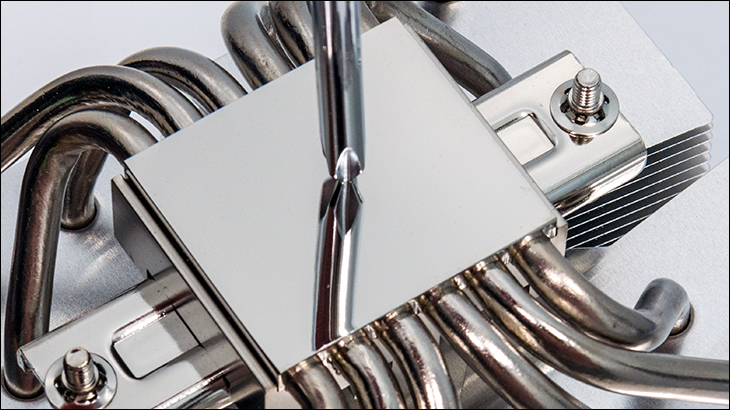
Overall it is obvious that Scythe have spent a lot of time and effort refining their basic Ninja design. Their attention detail is impressive. Though the easiest single thing that shows how much time and effort Scythe spends on their Ninja is the base. The base of our Ninja 5 is polished and finished to a mirror shine. So much so it actually makes the Mugen 5’s look sloppily completed in comparison.

Before move on to the installation section there is one thing that demands to be covered. That is the included fans. Yes, Scythe includes two of them. Unfortunately, the Ninja 5 is similarly equipped to the Mugen 5 PCGH edition in that they include two fans that max out at a mere 800rpms. This is the weak link of the Ninja 5. While these slow fans show off how efficient and effective the Ninja 5 desing is, and shows off how quiet it can be while still keeping temperatures in check, two 1200 Scythe Kaze Flex RGB fans would have been more flexible. Even a pair of the 1200 Scythe Kaze Flex PWM fans (i.e. the same model that ships with the Mugen 5) would have resulted in a noticeably better performance. We know Scythe makes good fans, and while these are long lived, and truly silent fans… it does put the Scythe Ninja 5 at a distinct disadvantage compared to other dual tower designs which ship with – at the very least – 1200rpm fans. Mix in the fact that they are not RGB LED equipped… and the end result is a drop dead gorgeous looking cooler but one that could have been even more enticing. It is the cooler equivalent of dating a model… vs. dating a super</>-model.
Since we do have a pair of Kaze Flex ‘1200rpm’ fans (which actually spin at well over 1320rpm) we are going to use them for the review. That way you can see what it can do in stock configuration… and what you are missing out on by not swapping them out for higher speed fans. Once again it is speed/ air flow that this cooler craves… not static pressure. You really will not need 38mm thick Yate Loon ‘D’ fans, just faster fans to get the most out of the Ninja 5.



